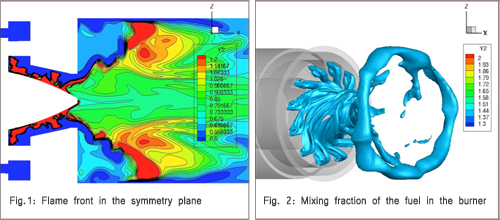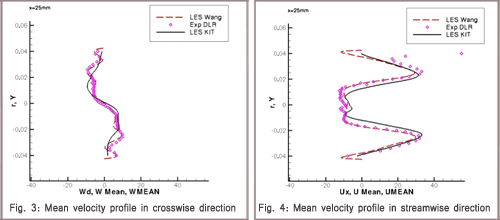ENGINEERING AND CFD
Prediction of Stability Limits of Combustion Chambers with Large Eddy Simulation (LES)
Principal Investigator:
Franco Magagnato
Affiliation:
Karlsruhe Institute of Technology
Local Project ID:
fsm606_2
HPC Platform used:
Hermit of HLRS
Date published:
It is well known that in order to fulfil the stringent demands for low emissions of NOx, the lean premixed combustion concept is commonly used. However, lean premixed combustors are susceptible to thermo acoustic instabilities driven by the combustion process and possibly sustained by a resonant feedback mechanism coupling pressure and heat release. This resonant feed back mechanism creates pulsations typically in the frequency range of several hundred Hz and which reach high amplitudes so that the system has to be shut down or is even damaged. Although the research activities of the recent years have contributed to a better understanding of this phenomenon the underlying mechanisms are still not well enough understood.
For the prediction of the stability of technical combustion systems regarding the development and maintaining of self-sustained combustion instabilities the knowledge of the periodic-non-stationary mixing and reacting behaviour of the applied flame type (flame model) and a quantitative description of the resonance characteristic of the gas volumes in the combustion chamber is conclusively needed. Combustion instabilities are characterised by the time-dependent heat release rate of the flame as well as by the time-dependent static pressure within the combustion chamber or the connected volumes like mixing unit, burner plenum, or exhaust gas system. A possibility to describe periodic combustion instabilities is to calculate the observed frequency by using the geometric parameters of the resonating volume, i.e. the eigenfrequency. In this calculation the damping in the system is neglected. In real systems there is, however, always a certain amount of damping. It has an important role to limit the amplification of pulsation in the range of the resonant frequency.
At the Karlsruhe Institute of Technology a physical model to predict the resonance characteristics of real, damped combustion systems was developed. As the result of the foregoing research the model is able to describe the resonant characteristics of a single Helmholtz resonator type combustor for different operation conditions and geometries. It is important to mention that this model describes the system in the low frequency range and does not cover the high frequency instabilities.
In order to understand the mechanisms related to pulsations in a complex combustion system it is necessary but not sufficient to predict the resonant characteristics only of the single components. The model was extended therefore for the coupled system of burner and combustion chamber. This is an indispensable step to enable the prediction of the resonance characteristic of combustion systems existing of numerous different volumes like mixing unit, air/fuel supply, burner plenum, combustion chamber and the components of the exhaust gas system. In order to prove the prediction of the model for the coupled system different geometric parameters such as burner volume, resonator geometry and, furthermore, operating parameters such as mean volume flow rate were varied under isothermal conditions.
By means of numerical simulation and the physical model the resonance characteristics of a combustion system can be predicted during the design phase already. The main goal of the numerical investigation is to predict the damping coefficient of the system which is an important input for the physical model. In order to provide an insight into the flow mechanics inside the system LES (Large Eddy Simulations) were carried out. LES is an approach to simulate turbulent flows based on resolving the unsteady large-scale motion of the fluid while the impact of the small-scale turbulence on the large scales is accounted for by a sub-grid scale model. By the prediction of flows in complex geometries, where large, anisotropic vortex structures dominate, the statistical turbulence models often fail. The LES approach is for such flows more reliable and more attractive as it allows more insight into the vortex dynamics. In recent years the rapid increase of computer power has made LES accessible to a broader scientific community. This is reflected in an abundance of papers on the method and its applications.
The solution of the fully compressible Navier-Stokes equations was essential to capture the physical response of the pulsation amplification, which is mainly the compressibility of the gas volume in the chamber. Viscous effects play a crucial role in the oscillating boundary layer in the neck of the Helmholtz resonator and, hereby, in the damping of the pulsation. The pulsation and the high shear in the resonator neck produce highly anisotropic swirled flow. Therefore it is improbable that an Unsteady Reynolds Averaged Navier-Stokes Simulation (URANS) can render such flow reliably.
The results of the investigation of the single resonator showed that LES can predict accurately the resonant characteristics of the single resonator and the damping, respectively. In the present work the ability of LES predicting the resonant characteristics of the coupled system was investigated. The mesh for the LES was optimized on the findings of the investigations of the single resonator in the previous phase. The resonator characteristics predicted by the numerical simulation were in very good agreement with the data from the experiments.
In the computation of these results the scientists used up to 1,344 AMD-Interlagos cores of the CRAY XE6 (Hermit) at the HLRS Stuttgart. The in-house developed code Sparc is parallized with the MPI-2 software. The computational time for one unsteady calculation in three dimesions using about 10 million points was about 24h. Since more than 10,000 blocks of the finite volume scheme were used, the blocks on these 1,344 cores could efficiently be distributed with the domain decomposition technique. The load balancing was at about 99%. The parallel efficiency was also very good. Since in Stuttgart the communication is done with the CRAY GEMINI node-node interconnection the parallel efficiency was close to 95%. This very good parallel efficiency could only be obtained because the amount of output was reduced to a minimum. It is desired that the amount of output data should be increased so the read/write performance of the code needs to be improved in the near future. The recent investigations revealed that a higher resolution of the computational mesh is required. It is estimated that using about 80 million points in the next phase will be adequate for a well resolved unsteady calculation.

© Institute of Fluid Mechanics, Karlsruhe Institute of Technology

© Institute of Fluid Mechanics, Karlsruhe Institute of Technology
Acknowledgements
The present work is a part of the subproject A7 of the Collaborative Research Centre (CRC) 606 – “Unsteady Combustion: Transportphenomena, Chemical Reactions, Technical Systems” at the Karlsruhe Institute of Technology. The project is supported by the German Research Foundation.
Scientific Contact:
Dr.-Ing. Franco Magagnato
Institute of Fluid Mechanics
Karlsruhe Institute of Technology
Kaiserstrasse 12, D-76131 Karlsruhe, Germany
e-mail: franco.magagnato@kit.edu